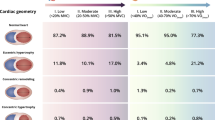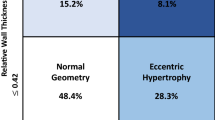Abstract
Physiological hypertrophy in response to physical training is important in the differentiation of physiological and pathological left ventricular hypertrophy. The goal of our study was to define the structural characteristics of the heart in Chinese athletes. Between June 2005 and August 2005, 339 (165 male, 174 female) elite Chinese athletes from 19 sports were profiled. Standard two-dimensional guided M-mode and Doppler echocardiography were employed to evaluate left ventricular morphology and function. Of the 165 male athletes, 19 (11.5%) male athletes presented with an LVIDd ≥ 60 mm, with an upper limit of 65 mm. Only three male athletes presented with wall thickness values ≥13 mm. Eighteen (10.3%) female athletes presented with an LVIDd ≥ 50 mm, and seven (4.2%) female athletes presented with an LVIDd ≥ 55 mm, with an upper limit of 62 mm. None were found to have a maximum wall thickness greater than 11 mm. Systolic and diastolic functions were within normal limits for all athletes. Results from the present study suggest that upper normal limits for left ventricular wall thickness and LVIDd are 14 and 65 mm for elite male Chinese athletes, and 11 mm and 62 mm for elite female Chinese athletes. Values in excess of these should be viewed with caution and should prompt further investigation to identify the underlying mechanism for the observed left ventricular hypertrophy.
Similar content being viewed by others
Change history
16 March 2023
This article has been retracted. Please see the Retraction Notice for more detail: https://doi.org/10.1007/s00421-023-05179-3
References
Caso P, D’Andrea A, Caso I, Severino S, Calabro P, Allocca F, Mininni N, Calabro R. 2006. The athlete’s heart and hypertrophic cardiomyopathy: two conditions which may be misdiagnosed and coexistent. Which parameters should be analysed to distinguish one disease from the other? J Cardiovasc Med (Hagerstown) 7(4):257–66
Devereux RB, Alonso DR, Lutas EM, Gottlieb GJ, Campo E, Sachs I et al (1986) Echocardiographic assessment of left ventricular hypertrophy: comparison to necropsy findings. Am J Cardiol 57:450–458
Dorn GW 2nd, Force T (2005) Protein kinase cascades in the regulation of cardiac hypertrophy. J Clin Invest 115(3):527–537
Douglas PS, O’Toole ML, Katz SE, Ginsburg GS, Hiller WD, Laird RH (1997) Left ventricular hypertrophy in athletes. Am J Cardiol 80:1384–1388
Gavazzi A, De Maria R, Renosto G (1993) The spectrum of left ventricular size in dilated cardiomyopathy: clinical correlates and prognostic implications. Am Heart J 125:410–422
George K, Gates P, Whyte G, Fenoglio RA, Lea R (1999) Echocardiographic examination of cardiac structure in elite crosstrained male and female alpine skiers. Br J Sports Med 33:93–99
George KP, Wolfe LA, Burggraf GW (1991) The “athletic heart syndrome”. Sports Med 11:300–330
Hernandez D, de la Rosa A, Barragan A, Barrios Y, Salido E, Torres A, Martin B, Laynez I, Duque A, De Vera A, Lorenzo V, Gonzalez A (2003) The ACE/DD genotype is associated with the extent of exercise-induced left ventricular growth in endurance athletes. J Am Coll Cardiol 42(3):527–532
Klues HG, Schiffers A, Maron BJ (1995) Phenotypic spectrum and patterns of left ventricular hypertrophy in hypertrophic cardiomyopathy: morphologic observations and significance as assessed by two-dimensional echocardiography in 600 patients. J Am Coll Cardiol 26:1699–1708
Krieg A, Scharhag J, Kindermann W, Urhausen A (2007) Cardiac tissue Doppler imaging in sports medicine. Sports Med 37(1):15–30
Maron BJ (2002) Hypertrophic cardiomyopathy: a systematic review. JAMA 287:1308–1320
Maron BJ, Pelliccia A (2006) The heart of trained athletes: cardiac remodeling and the risks of sports, including sudden death. Circulation 114(15):1633–1644
Maron BJ, McKenna WJ, Danielson GK, Kappenberger LJ, Kuhn HJ, Seidman CE et al (2003) American College of Cardiology/European Society of Cardiology clinical expert consensus document on hypertrophic cardiomyopathy: a report of the American College of Cardiology Foundation Task Force on clinical expert consensus documents and the European Society of Cardiology Committee for practice guidelines. J Am Coll Cardiol 42:1687–1713
Maron BJ, Seidman JG, Seidman CE (2004) Proposal for contemporary screening strategies in families with hypertrophic cardiomyopathy. J Am Coll Cardiol 44:2125–2132
Maron BJ, Douglas PS, Graham TP, Nishimura RA, Thompson PD (2005) Task Force 1: preparticipation screening and diagnosis of cardiovascular disease in athletes. J Am Coll Cardiol 45(8):1322–1326
Montgomery HE, Clarkson P, Dollery CM, Prasad K, Losi MA, Hemingway H, Statters D, Jubb M et al (1997) Association of angiotensin-conversting enzyme gene I/D polymorphism with change in left ventricular mass in response to physical training. Circulation 96:741–747
Nagueh SF, Bachinski LL, Meyer D, Hill R, Zoghbi WA, Tam JW et al (2001) Tissue Doppler imaging consistently detects myocardial abnormalities in patients with hypertrophic cardiomyopathy and provides a novel means for an early diagnosis before and independently of hypertrophy. Circulation 104:128–130
Pelliccia A, Dipaolo FM (2005) Cardiac remodeling in women athletes and implications for cardiovascular screening. Med Sci Sports Exerc 37(8):1436–1469
Pelliccia A, Maron BJ, Spataro A, Proschan MA, Spirito P (1991) The upper limits of physiologic cardiac hypertrophy in highly trained athletes. N Engl J Med 324:295–301
Pelliccia A, Maron BJ, Culasso F, Spataro A, Caselli G (1996) Athlete’s heart in women. Echocardiographic characterization of highly trained elite female athletes. JAMA 276(3):211–215
Pelliccia A, Culasso F, Di Paolo FM, Maron BJ (1999) Physiologic left ventricular cavity dilatation in elite athletes. Ann Intern Med 130:23–31
Pelliccia A, Avelar E, De Castro S, Pandian N (2000) Global left ventricular shape is not altered as a consequence of physiologic remodeling in highly trained athletes. Am J Cardiol l86:700–702
Sakamoto M, Minamino T, Toko H, Kayama Y, Zou Y, Sano M et al (2006) Upregulation of heat shock transcription factor 1 plays a critical role in adaptive cardiac hypertrophy. Circ Res 99(12):1411–1418
Sahn DJ, DeMaria A, Kisslo J, Weyman A (1978) Recommendations regarding quantitation in M-mode echocardiography: results of a survey of echocardiographic measurements. Circulation 58:1072–1083
Scharhag J, Schneider G, Urhausen A, Rochette V, Kramann B, Kindermann W (2002) Athlete’s heart: right and left ventricular mass and function in male endurance athletes and untrained individuals determined by magnetic resonance imaging. J Am Coll Cardiol 40(10):1856–1863
Sharma S, Whyte G, McKenna WJ (1997) Sudden death from cardiovascular disease in young athletes: fact or fiction? Br J Sports Med 31(4):269–276
Urhausen A, Kindermann W (1992) Echocardiographic findings in strengthand endurance-trained athletes. Sports Med 13:270–284
Urhausen A, Kindermann W (1999) Sports-specific adaptations and differentiation of the athlete’s heart. Sports Med 28(4):237–44
Urhausen A, Monz T, Kindermann W (1997) Echocardiographic criteria of physiological left ventricular hypertrophy in combined strength- and endurance-trained athletes. Int J Card Imaging 13(1):43–52
Whyte G, George K, Sharma S (2000) Left ventricular structure and function in elite Judo players. J Clin Exp Phys 2:204–208
Whyte GP, George K, Nevill A, Shave R, Sharma S, McKenna WJ (2004a) Left ventricular morphology and function in female athletes: a meta-analysis. Int J Sports Med 25(5):380–383
Whyte GP, George K, Sharma S, Firoozi S, Stephens N, Senior R, McKenna WJ (2004b) The upper limit of physiological cardiac hypertrophy in elite male and female athletes: the British experience. Eur J Appl Physiol 92(4–5):592–597
Zhao SH, Liu YM, Yao JB (1984) The surface area measurement of adult man in China. Acta Nutrimenta Sinica 6:87
Acknowledgments
This work was supported by a grant from Sport Foundation of Jiangsu Province (TY6109). We thank physician Wang for giving some suggestions.
Author information
Authors and Affiliations
Corresponding author
About this article
Cite this article
SUN, B., MA, J., YONG, Y. et al. RETRACTED ARTICLE: The upper limit of physiological cardiac hypertrophy in elite male and female athletes in China. Eur J Appl Physiol 101, 457–463 (2007). https://doi.org/10.1007/s00421-007-0517-5
Accepted:
Published:
Issue Date:
DOI: https://doi.org/10.1007/s00421-007-0517-5




